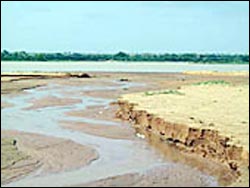Soil Scientist Controls Erosion to Restore West Africa’s Sahel

Sedimentation in the Niger River has decreased soil fertility and threatens the economic stability of the region.
An Iowa State University agronomy professor is using erosion control methods to restore the Sahel and Niger River in West Africa.
Andrew Manu, associate professor of soil science, has been working with the people of Niger to restore degraded lands in the Sahel, the region of West Africa that separates the Sahara Desert from the savannah. Land degradation is threatening the economic stability of the region. “There is hope in the Sahel,” Manu said. “We can restore the Sahel and make it work for the people.”
Manu will present his findings at the 2004 international annual meetings of the American Society of Agronomy, Crop Science Society of America and Soil Science Society of America in Seattle, Wash., Oct. 31 to Nov. 5.
The Sahel has degraded because large human and livestock populations and increased cultivation have reduced native vegetation in the area. As a result, excessive runoff has increased erosion and decreased soil fertility. Sediment carried by the runoff is deposited into the Niger River, where it creates alluvial fans—unproductive landforms made of the transported soil and rock from the Sahel. Manu and his colleagues devised a way to prevent further erosion and sediment deposits through reforestation using microcatchments.
“Microcatchments are crescent-shaped trenches, about four feet in length, built on plateaus in the path of erosion,” Manu said. “The trenches catch and hold moving water and sediment, preventing sediment from polluting the river. We plant trees and vegetation in the trenches to use collected water, and provide extra ground cover to further reduce erosion. People in the area also use the trees for firewood and lumber and the grasses as pasture for livestock.”
Manu is working with Niger’s Department of the Environment and National Agricultural Institute to promote the use of microcatchments in plateaus along the river.
While the biggest impact of his work is felt in the villages of this West African country, Manu said his research has implications in Iowa.
“The world is a global village now – whatever happens in Niger affects us here in Iowa. These solutions may be used elsewhere in the future, perhaps in Iowa, to solve similar erosion problems,” Manu said.
Using archived satellite imagery and modeling technology, Manu recreated the way the Niger River looked in 1973 and 1988. He compared the previous and present conditions of the river near Niamey, the capital of Niger. Manu said the Niger River was in near pristine condition in 1973; however, by 1988, some branches of the river had been closed by sediment. Today, sediment has damaged water quality and created large unproductive alluvial fans that obstruct the river.
In addition to the use of microcatchments, Manu also suggests stricter environmental regulations to prevent people from removing erosion barriers, such as trees and soil, from affected areas. Manu plans further research to study the impact of the microcatchments on soil quality in the area.
Media Contact
More Information:
http://www.iastate.eduAll latest news from the category: Ecology, The Environment and Conservation
This complex theme deals primarily with interactions between organisms and the environmental factors that impact them, but to a greater extent between individual inanimate environmental factors.
innovations-report offers informative reports and articles on topics such as climate protection, landscape conservation, ecological systems, wildlife and nature parks and ecosystem efficiency and balance.
Newest articles

Silicon Carbide Innovation Alliance to drive industrial-scale semiconductor work
Known for its ability to withstand extreme environments and high voltages, silicon carbide (SiC) is a semiconducting material made up of silicon and carbon atoms arranged into crystals that is…

New SPECT/CT technique shows impressive biomarker identification
…offers increased access for prostate cancer patients. A novel SPECT/CT acquisition method can accurately detect radiopharmaceutical biodistribution in a convenient manner for prostate cancer patients, opening the door for more…

How 3D printers can give robots a soft touch
Soft skin coverings and touch sensors have emerged as a promising feature for robots that are both safer and more intuitive for human interaction, but they are expensive and difficult…





















